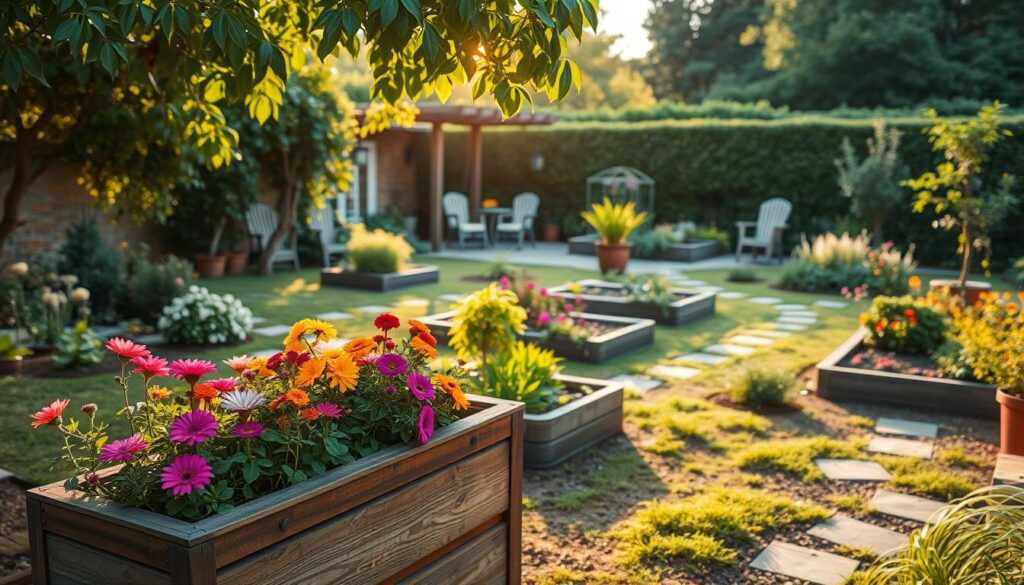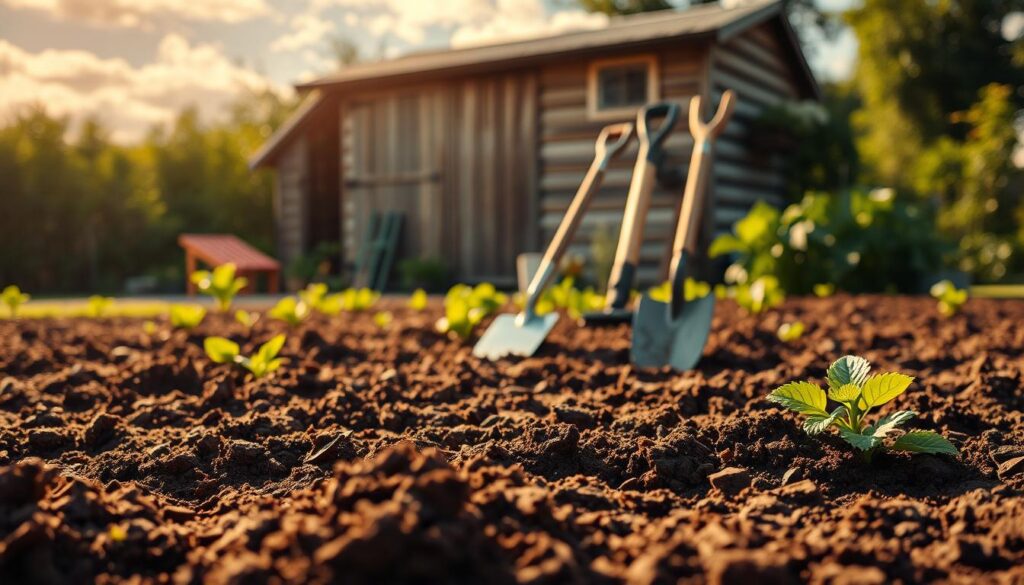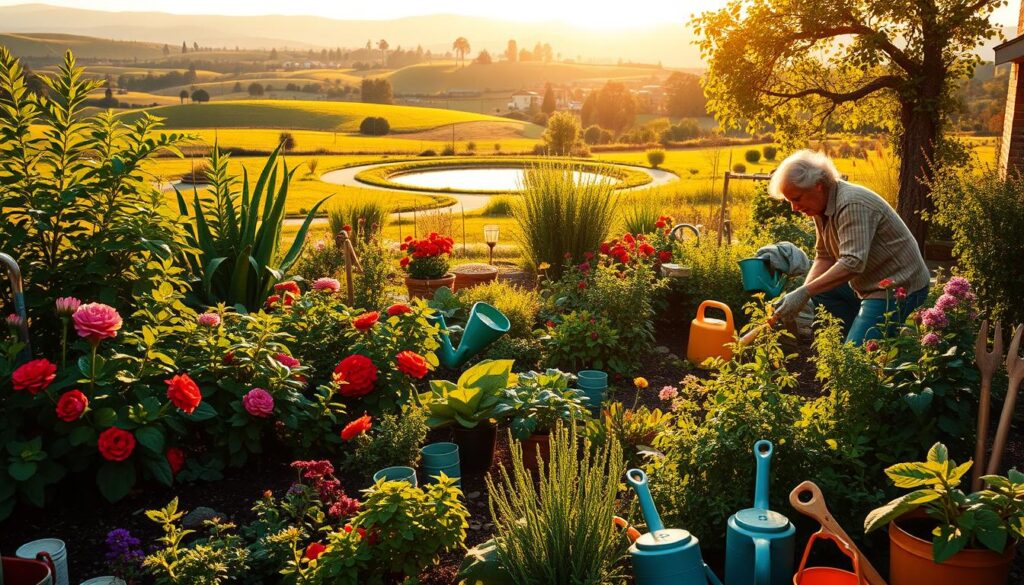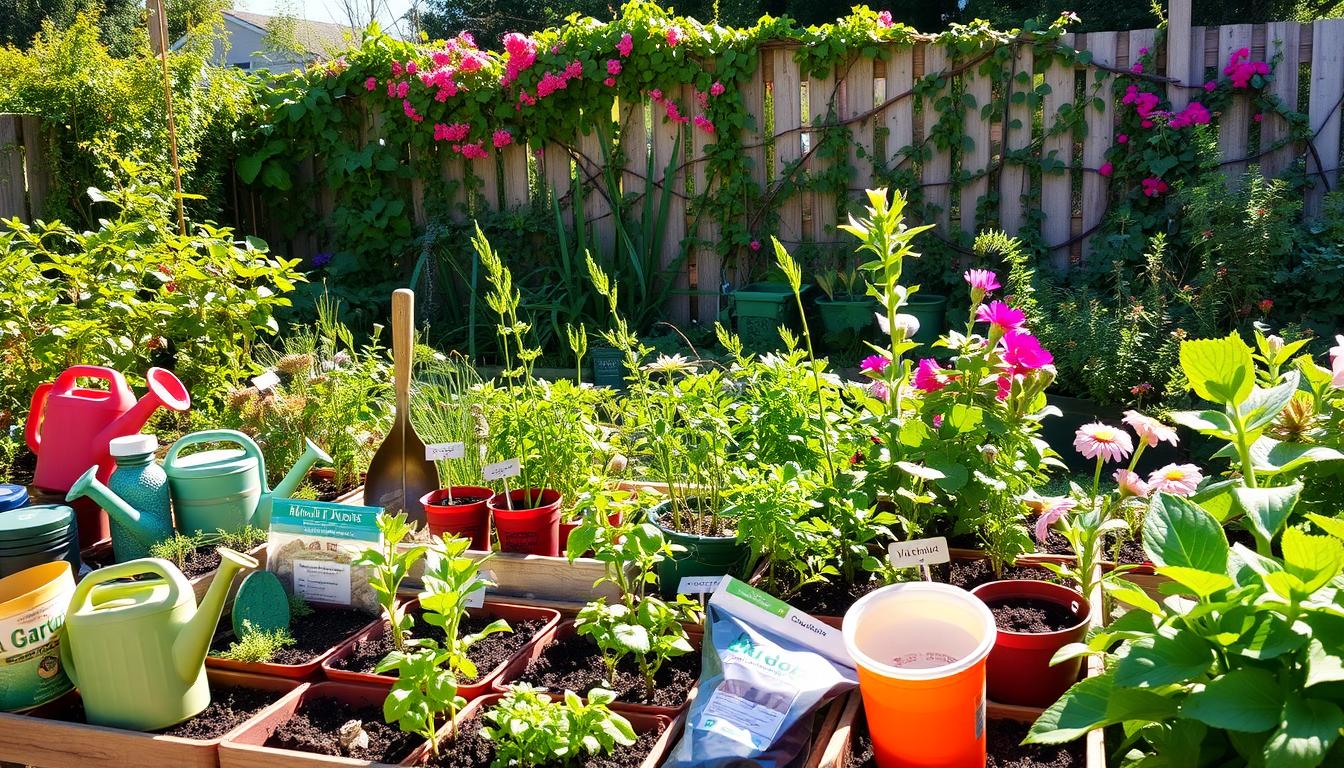Transforming your outdoor space into a stunning garden oasis is easier than you think. Whether you’re a beginner or have some experience, starting small is the key to success. A 10×10 garden or raised beds can make a big difference, especially if your soil isn’t ideal.
Gardening offers more than just fresh vegetables and beautiful flowers. It’s a rewarding activity that boosts mental well-being. By focusing on 5-10 plant species per season, you can avoid feeling overwhelmed and enjoy the process.
Spring is the perfect time to start. Begin with easy-to-grow seeds like sunflowers or zinnias. Companion planting, such as pairing marigolds with vegetables, can also enhance your garden’s health. Remember, trial and error is part of the journey, so don’t be afraid to experiment.
Key Takeaways
- Start small with a 10×10 garden or raised beds.
- Focus on 5-10 plant species per season for better results.
- Spring is the ideal time to begin your garden.
- Try companion planting to improve plant health.
- Experiment with easy-to-grow seeds like sunflowers and zinnias.
1. Planning Your Backyard Garden
A well-planned garden starts with understanding your space and setting clear goals. Whether you’re growing vegetables or flowers, smart planning ensures your garden thrives. Begin by assessing your area, mapping out your vision, and avoiding common mistakes.

Assessing Your Space
Start by calculating your usable space. Use smartphone apps to measure dimensions accurately. In urban environments, consider microclimates—shade patterns from buildings can affect plant growth. For beginners, a 100 sq ft in-ground garden or a 4×8 ft raised bed is ideal.
“The key to a successful garden is understanding your space and its unique conditions.”
Setting Realistic Goals
Set achievable goals based on your time and resources. Avoid overplanting—focus on 5-10 plant species per season. Introduce succession planting for a continuous harvest. This method ensures your garden remains productive throughout the year.
Creating a Garden Map
Map your garden using tools like Garden Planner software or grid paper. Color-coding helps visualize plant placement. Follow square foot gardening principles for efficient use of space. Leave access paths every 4 feet for easy maintenance.
| Garden Type | Recommended Size | Benefits |
|---|---|---|
| In-Ground | 100 sq ft | Cost-effective, natural soil use |
| Raised Beds | 4×8 ft | Better soil control, easier access |
Plan wisely to avoid common mistakes like ignoring mature plant sizes. Test your soil quality and ensure proper drainage. For more tips, check out this beginner’s guide to gardening.
2. Choosing the Perfect Location
Finding the right spot for your garden can make all the difference in its success. The location you choose affects sunlight exposure, water access, and soil quality. These factors determine how well your plants will grow and thrive.

Sunlight and Water Access
Most vegetables need at least 8 hours of sunlight daily. Use apps like Sun Seeker to track sunlight patterns in your space. This ensures your plants get the light they need to flourish.
Water access is equally important. Ensure your garden is near a water source or consider installing a rainwater collection system. Drought-resistant vegetables like zucchini and peppers are great for low-water areas.
Soil Quality and Drainage
Healthy roots depend on good soil. Test your soil’s texture—clay, sandy, or loam—using kits from Botanical Interests. Loam is ideal for most plants, but amendments can improve other soil types.
Drainage is crucial. Dig a 12-inch hole, fill it with water, and observe how quickly it drains. Poor drainage? Consider installing a French drain to prevent waterlogging.
Considering Raised Beds
Raised beds offer better soil control and easier access. Cedar and pine are popular lumber choices for construction. Compare the costs of native soil amendments versus raised bed installation to decide what works best for you.
| Option | Cost | Benefits |
|---|---|---|
| Native Soil Amendment | $50-$100 | Improves existing soil, cost-effective |
| Raised Bed Installation | $150-$300 | Better drainage, easier maintenance |
Refer to the USDA hardiness zone map to understand your local weather conditions. This helps you choose plants that thrive in your area. With the right location, your garden will be set up for success.
3. Selecting the Right Plants for Your Backyard
Choosing the right plants can transform your garden into a thriving, colorful space. Whether you’re growing vegetables or flowers, selecting species suited to your environment ensures success. Start with beginner-friendly options and expand as you gain confidence.

Beginner-Friendly Vegetables
For new gardeners, starting with easy-to-grow vegetables is key. Radishes and bush beans are excellent choices—they germinate quickly and require minimal care. Radishes can be harvested in just 21 days, while bush beans take about 50 days.
Consider lettuce and tomatoes for variety. Lettuce grows well in cooler weather, and tomatoes thrive in warm seasons. Hybrid seeds often have higher germination rates, while heirloom varieties offer unique flavors.
Easy-to-Grow Flowers
Adding flowers to your garden enhances its beauty and attracts pollinators. Nasturtiums and borage are foolproof options. They bloom quickly and require little maintenance. For continuous color, try seed mixes from Renee’s Garden.
Be cautious with invasive perennials like mint and bamboo. While they grow easily, they can overtake your garden if not managed properly.
Seasonal Planting Tips
Understanding your local season is crucial for a successful harvest. Use a planting calendar to track frost dates and plan accordingly. Cool-season crops like lettuce thrive in early spring, while warm-season plants like tomatoes do best in summer.
Succession planting ensures a continuous supply of fresh produce. Pair compatible plants, like tomatoes and basil, to improve growth and deter pests. A companion planting chart can guide your choices.
“The right plants in the right place make all the difference in your garden’s success.”
- Compare hybrid and heirloom seeds for germination rates.
- Use a planting calendar to track frost dates.
- Pair tomatoes with basil for natural pest control.
- Avoid invasive perennials like mint and bamboo.
4. Preparing and Planting Your Garden
Proper soil preparation and plant spacing are essential for a thriving garden. Whether you’re growing vegetables or flowers, these steps ensure your plants have the best start. Focus on techniques that improve soil health and optimize space for better yields.

Soil Preparation Techniques
Healthy soil is the foundation of a successful garden. Start with lasagna gardening, a layering technique that builds nutrient-rich beds. Alternate layers of compost, straw, and leaves to create a fertile environment for your plants.
Compare seed starting mixes like peat and coconut coir. Peat is widely used but less sustainable, while coconut coir is eco-friendly and retains moisture well. Choose the mix that suits your needs and budget.
Use a germination temperature chart to ensure your seeds sprout at the right time. Most vegetables thrive between 65°F and 75°F. Adjust your planting schedule based on local weather conditions.
Plant Spacing and Layout
Proper spacing prevents overcrowding and promotes healthy growth. For root vegetables like carrots, follow the 2x width rule for seed depth. This ensures strong root development and better yields.
Try interplanting strategies, such as pairing radishes with carrots. Radishes grow quickly and loosen the soil, making it easier for carrots to thrive. Vertical gardening is another great option for small spaces.
Here’s a quick guide to plant spacing:
| Plant | Spacing |
|---|---|
| Carrots | 2-3 inches |
| Radishes | 1-2 inches |
| Lettuce | 6-8 inches |
Starting Seeds Indoors vs. Direct Sowing
Starting seeds indoors gives you a head start on the growing season. Use tools like soil blockers or seed trays for better results. Peat pellets are a popular choice for their convenience and ease of use.
For direct sowing, wait until the soil is warm enough. High Mowing Seeds’ pelleted carrot seeds are perfect for this method. They’re easy to handle and ensure even spacing.
Harden off your seedlings before transplanting them outdoors. Gradually expose them to outdoor conditions over 7-10 days. This reduces the risk of transplant shock and helps them adapt to their new environment.
5. Maintaining Your Backyard Garden
Keeping your garden healthy and productive requires consistent care and attention. From watering to pest control, each task plays a vital role in ensuring your plants thrive. With the right strategies, you can enjoy a bountiful harvest and a beautiful garden all season long.

Watering and Weeding Tips
Proper water management is essential for healthy plants. Compare drip irrigation and soaker hoses to find the best fit for your garden. Drip systems deliver water directly to the roots, reducing waste, while soaker hoses are ideal for larger areas.
Weeding regularly prevents unwanted plants from competing for nutrients. Mulching around your vegetables and crops can suppress weeds and retain moisture. For leafy greens like lettuce, succession harvesting ensures a continuous supply.
Dealing with Pests and Weather
Pests can threaten your garden, but natural solutions like neem oil and castile soap sprays are effective and eco-friendly. Plant pest-resistant flowers like marigolds to deter insects naturally.
Protect your plants from extreme weather with row covers. These shields guard against frost and provide shade during heatwaves. Monitor for drought symptoms, such as wilting leaves, and adjust your watering schedule accordingly.
Harvesting and Enjoying Your Produce
Timing is key when it comes to harvesting. Tomatoes are best picked when fully ripe, while zucchini should be harvested young for the best flavor. Use techniques from Three Acre Farm to condition cut flowers for longer vase life.
Preserve your bounty by freezing kale or other leafy greens. Keep a garden journal with photos to track progress and learn from each growing time. Crop rotation also helps prevent diseases and keeps your soil healthy.
“A well-maintained garden is a source of joy and nourishment throughout the year.”
Conclusion
Creating a thriving garden is a journey filled with learning and rewards. From planning your space to enjoying your first harvest, each step brings you closer to a vibrant outdoor haven. This season, celebrate your progress and share your experience with others through garden tours or seed swaps.
Looking ahead, consider expanding your garden next year with fruit bushes or new vegetables. Tools like the Almanac Garden Planner can help you stay organized and inspired. For those eager to dive deeper, Lori’s “Backyard Cutting Garden 101” course offers expert guidance to elevate your skills.
Remember, every gardener starts somewhere. A first-time gardener once shared, “Seeing my plants thrive was the most rewarding feeling.” Keep experimenting, and don’t forget to enjoy the process. Your garden is a reflection of your dedication and love for nature.

